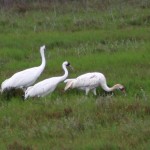by Chester McConnell, WCCA
Whooping Crane Conservation Association (WCCA) president Lorne Scott has urged Secretary Ken Salazar, U.S. Department of the Interior to resume regular aerial total population counts of whooping cranes on Aransas Refuge. The aerial census of the total whooping crane population has been used for the past 61 years. During 2012, the U.S. Fish and Wildlife Service decided to convert to a statistical survey method using hierarchical distance sampling. In a letter to Secretary Salazar, President Scott writes, “The WCCA sees the total count census as the most practical, economical and having the most scientific value”. Citing the Service’s “2011-2012 estimate of 254 plus or minus 62 Whooping Cranes”, Scott wrote, “This degree of uncertainty for a critically endangered species is simply unacceptable. President Scott’s letter is posted below:
January 4, 2013
Ken Salazar,
Secretary U.S. Department of the Interior
1849 C Street NW
Washington, DC 20240Dear Mr. Salazar:The annual winter census of endangered Whooping Cranes has been an event looked forward to by the conservation community since Aransas National Wildlife Refuge was established in 1937. The aerial total population count, done for the past 61 years, was changed by USFWS in the winter of 2011-2012 to a survey method using hierarchical distance sampling. As stated by USFWS, the new sampling method is only 85% accurate.The Whooping Crane Conservation Association (WCCA) believes the total population count is much preferred to the current estimate that has little value. Estimates are not satisfactory when dealing with this bird which is considered a flagship among all endangered species. Only about 300 birds exist in this wild population and it is still possible to do a total population count. Potentially, a dozen or even thirty five birds could die or disappear and the sampling technique would not detect the change. The new counting system only indicates that some low number of cranes are still present. It does not tell us whether this endangered population has increased or decreased from the previous year. The refuge’s 2011-2012 estimate of 254 plus or minus 62 Whooping Cranes does not serve any management purposes, nor does it provide worthwhile public information. This degree of uncertainty for a critically endangered species is simply unacceptable.
The Whooping Crane is an internationally endangered species, and as such the concerns of the international community should be considered. Because of this high level of interest, and the endangered status of the species, accurate total population counts should be continued annually.
The WCCA sees the total count census as the most practical, economical and having the most scientific value. Three aerial counts between December 1 and 20 would provide a good count of the total number of birds arriving in the winter population. Flights every two weeks, after the December 20 count, until the cranes return north, would provide estimates of population losses during the winter. We note that as of December 27, 2012, the Aransas Refuge new website still does not report any crane numbers from approximately seven flights conducted this fall. We urge you to resume regular aerial total population counts as soon as possible. The WCCA looks forward to continuing its support of the international Whooping Crane conservation efforts, as we have done for the past fifty years.
Sincerely,
Lorne Scott,
President
Whooping Crane Conservation Associationcc: Dan Ashe, Dr. Benjamin Tuggle, Hon. Peter Kent, Wendy Brown, Dr. Grant Harris, Aaron Archibecque, Sonny Perez, Dr. Wade Harrell, LeeAnn Linam, Dr. Rich Beilfuss, Dr. George Archibald, Joseph Duff, Dr. Mark Bidwell, Dr. Sandy Black, Ron Outen, Marty Folk, Alan Strand, Dr. Felipe Chavez-Ramirez, Dr. John French,Larry Schweiger, Wade Luzny
WCCA has previously expressed its concerns about the lack of reports on whooping crane nesting success on Canada’s Wood Buffalo National Park as well the winter aerial census on U.S. managed Aransas National Wildlife Refuge ( https://whoopingcrane.com/whooping-crane-program-concerns/ ) . The public in both the U.S and Canada is very interested in, and highly supportive of, the endangered whooping crane programs. WCCA has received a number of inquiries about the changes to the census program. Hopefully Secretary Salazar will get the program back on track.


